Procurement Strategy: The Full Guide


Procurement goes beyond just buying products and services for daily operations or production.
It involves securing the best quality and prices while aligning with broader organizational goals, such as ethical labor practices, environmental sustainability, and risk minimization.
Moreover, it’s about building long-term, mutually beneficial relationships with suppliers.
To achieve these objectives, your procurement department needs a robust procurement strategy.
This strategy should guide procurement toward sustainability, innovation in supplier relationships, and overall efficiency.
That is why today, we will dive deep into procurement strategy, its importance, and how to create an effective one.
But first, let’s distinguish between procurement and purchasing strategies.
A procurement strategy is a detailed plan that guides the procurement department on how to align purchasing activities with broader organizational goals.
It focuses on sourcing high-quality goods and services from reliable suppliers at the best prices.
But, in addition to this, your procurement strategy might also emphasize sustainability, process optimization, innovation, or global sourcing.
It all depends on the type of procurement strategy you go for.
Some of the most common ones include:
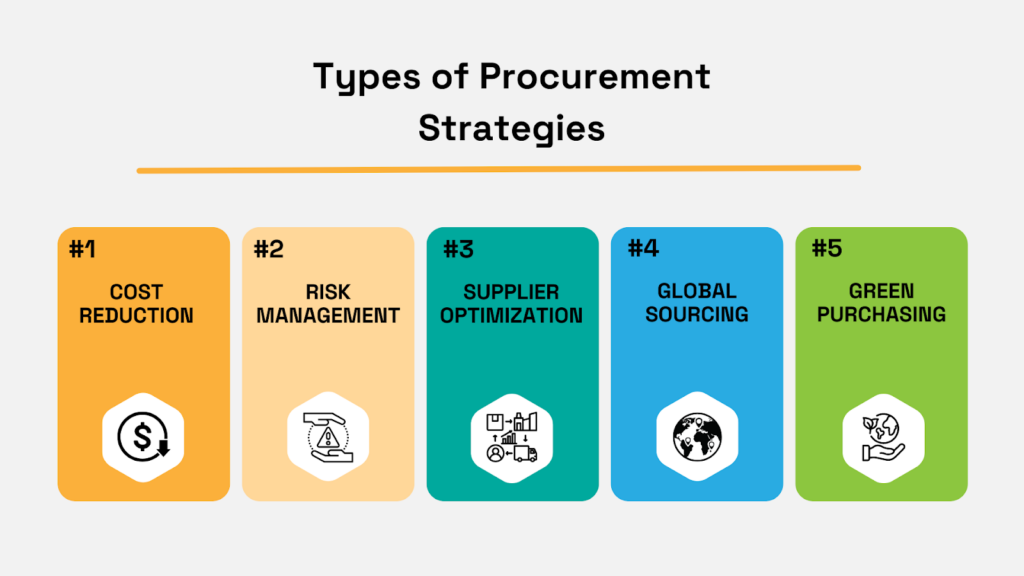
Source: Veridion
For example, if your goal is sustainability, your strategy will outline how to source sustainably and from diverse suppliers.
If risk management is your focus, the strategy will detail strict risk assessment and mitigation plans.
In contrast, a purchasing strategy defines how you buy, from placing orders to processing invoices.
The goal of the purchasing strategy is to streamline this process, reduce costs, and ensure timely delivery.
And, at the same time, reduce tail and maverick spend.
You can do that most efficiently by automating the procure-to-pay process.
In short, while purchasing focuses on instant, short-term goals, procurement strategy focuses on strategic, long-term objectives.
A solid procurement strategy brings companies numerous benefits, including financial savings, operational efficiency, and enhanced performance.
Let’s jump right into the examples.
Coca-Cola Bottlers’ Sales and Services (CCBSS), a stand-alone company owned by nearly 70 independent Coca‑Cola bottlers, takes a strategic approach to their procurement.
And they perfectly summarize the point of having a procurement strategy:
“What does “procurement” bring to mind? Savings. Economies of scale. Supply management. At CCBSS, our Procurement Services team is involved in all of those areas, plus many more. We take a strategic approach, working with our suppliers and customers not only on day-to-day delivery of materials but also innovation and sustainability.”
So, instead of solely focusing on obtaining materials on a daily basis, they collaborate closely with suppliers to enhance innovation and become more sustainable.
Their partner, Coca-Cola, is yet another shining example of why having a procurement strategy matters.
Their procurement strategy centers around supplier diversity, innovation, supplier performance management, and quality assurance.
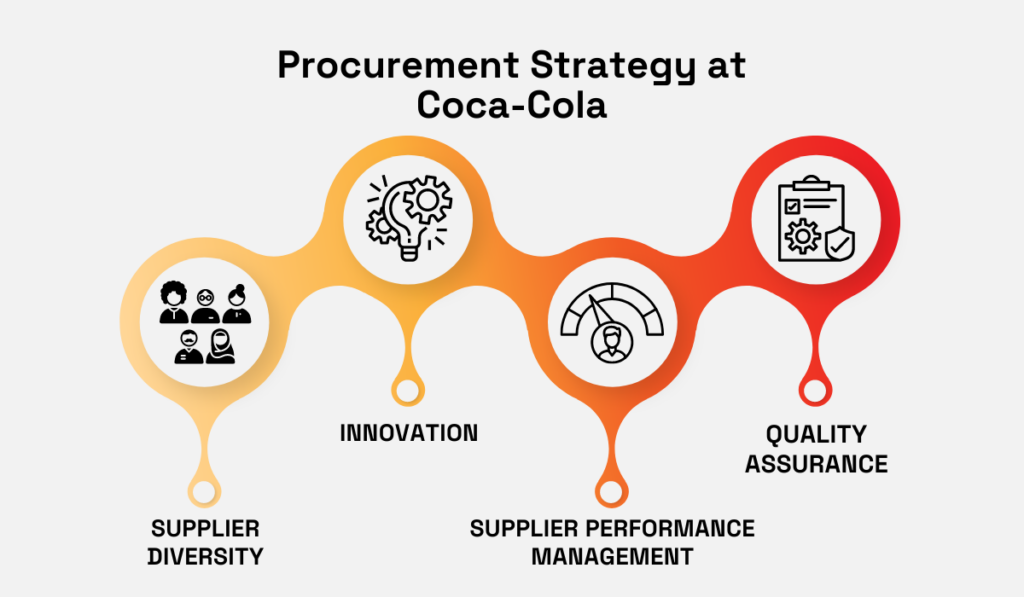
Illustration: Veridion / Data: Coca-Cola
They commit to spending at least $1 billion annually with diverse suppliers, ensuring a more inclusive supply chain.
They also prioritize local sourcing, with over 95% of their procurement spending targeting local suppliers.
Coca-Cola emphasizes supplier performance management by annually screening the performance of all critical suppliers, covering over 90% of its total procurement spend and more than 95% of its Tier 1 suppliers.
They also assess their suppliers’ ethical standards, human rights practices, and environmental and work safety requirements.
Finally, Coca-Cola continuously works with its suppliers on innovative solutions, from plant-based packaging to a simple, but innovative and sustainable paper sleeve you can see in the photo below:

Source: Flexible Packaging
All these strategies combined make Coca-Cola one of the most recognizable brands in the world.
Another excellent example of a company that implemented a brand new procurement strategy is Alcoa.
Alcoa is one of the world’s largest producers of aluminum, and they decided to develop a new global procurement strategy.
In the early 2000s, Alcoa’s procurement team initiated strategic sourcing efforts to stay ahead despite increasing competition and pricing pressures, including online and low-cost country sourcing, partnering with Ariba for support.
Alcoa started sourcing key materials like aluminum, energy, raw materials, and services from low-cost regions such as China, Russia, Spain, and India.
They utilized Ariba’s solutions for strategic sourcing, category management, low-cost country sourcing, and professional training.
Without compromising on quality, safety, or social responsibility, they achieved significant savings:
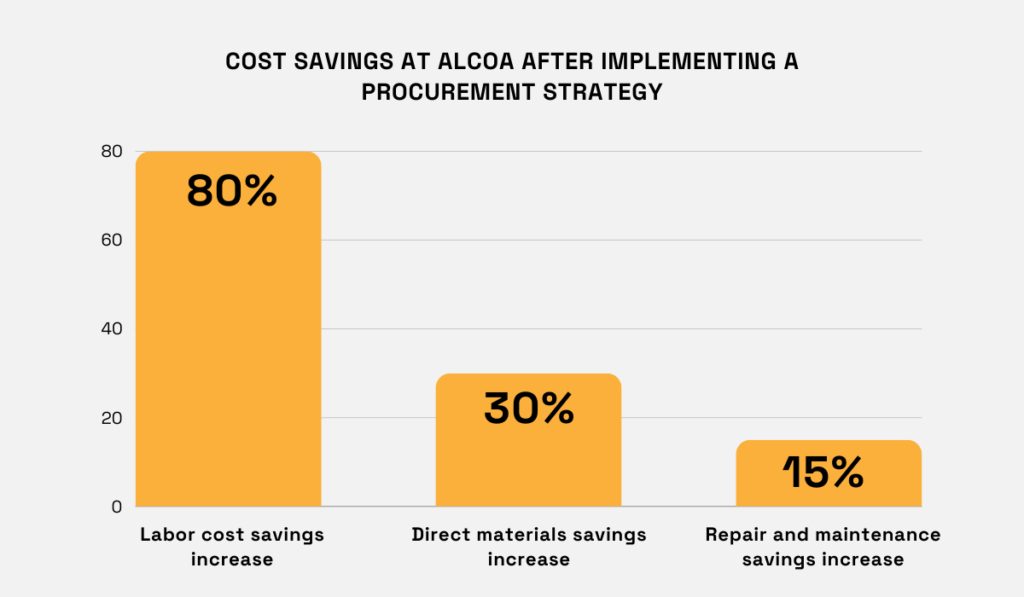
Illustration: Veridion / Data: SDC
To this day, they work on improving their sourcing efficiency and generating cost savings with digital solutions.
Why did we mention these three companies?
Each of them illustrates different facets of a procurement strategy.
CCBSS highlights the strategic, collaborative, and sustainable approach.
Coca-Cola demonstrates supplier diversity, local sourcing, performance management, and innovation.
Alcoa showcases global sourcing, technological integration, and significant cost savings.
These diverse examples collectively show us how well-defined procurement strategies not only help in managing costs but also ensure a steady supply of quality materials, support sustainability goals, and foster innovation.
In other words, the benefits of having a procurement strategy vary, and it all depends on the type of procurement strategy you choose to embrace.
But what does such a strategy entail?
Here are the key elements to include, explained through the lens of Unilever’s green purchasing procurement strategy aimed at becoming more sustainable in climate, nature, plastics, and livelihoods.
We will focus on their climate strategy, which targets reducing emissions and environmental impact.
Every procurement strategy, no matter the type, should begin with a clear and concise statement that defines the main focus of your procurement strategy.
For Unilever, that is achieving net zero emissions across their supply chain by 2039:
“Our ambition is to deliver net zero emissions across our value chain.”
This clear statement reflects Unilever’s commitment to sustainable procurement and sets a clear direction for its initiatives.
To achieve this, Unilever must transform its operations and collaborate with suppliers who share the same sustainability commitment.
Next, you should specify the goals and results you want to achieve. These should be clear, actionable targets.
For Unilever, the desired results focus on reducing greenhouse gas (GHG) emissions, and you can see them in the image below:
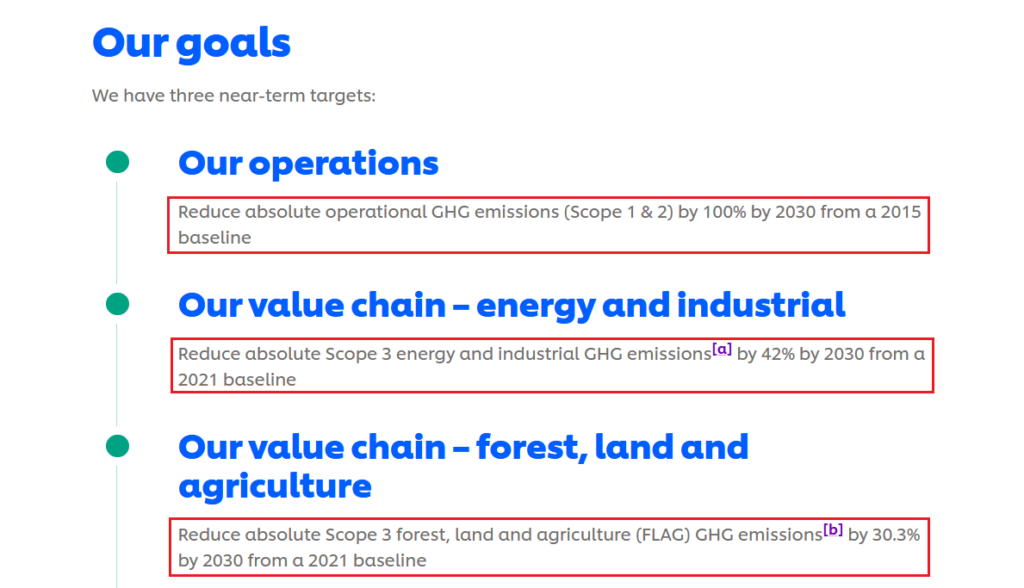
Source: Unilever
These goals are SMART: specific, measurable, achievable, relevant, and time-bound, ensuring they provide a clear roadmap for progress.
Then, a strategy should have defined time frames for achieving your goals.
These can be short-term, medium-term, or long-term.
Unilever’s time frames are clearly outlined:
Setting specific deadlines will help you maintain focus and urgency in executing the strategy.
At this point, you should detail the actions you will take to reach your goals.
This includes specific steps or a step-by-step guide to achieving your milestones.
Unilever’s Climate Transition Action Plan (CTAP), outlines specific actions across ten areas, from supplier climate programme to reformulating their own products.

Source: Unilever
Some of the actions include:
Overall, this is a part where you define exactly what steps and measures must be taken to achieve your strategic goals.
Every procurement strategy also has to have the metrics you will use to track progress. These should align with the goals of your strategy.
For example, if your focus is cost reduction, you should measure cost savings, cost avoidance, and other essential KPIs.
In Unilever’s case, the key metrics include:
Tracking these metrics allows Unilever to monitor their progress and make necessary adjustments.
For instance, tracking these KPIs showed that in 2023, they reduced Scope 1 and 2 GHG emissions in operations by 74% against a 2015 baseline, achieving their interim target ahead of schedule.
The last element of a procurement strategy involves identifying the tools and resources needed to implement the strategy and achieve the desired results.
These tools can range from auditing tools and training programs to supplier sourcing tools and spend analysis solutions.
But it can go beyond this.
Unilever, for instance, uses the latest technology to support its strategy, including satellite imaging and artificial intelligence, to increase visibility into its supply chains.
Willem Uijen, Unilever’s Chief Procurement Officer, explains the value of these tools:
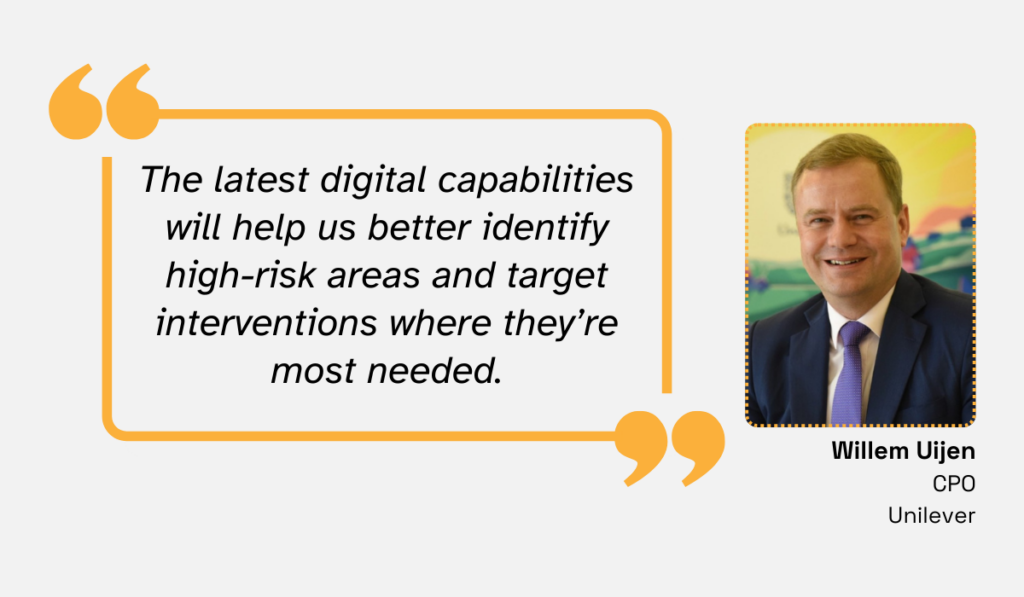
Illustration: Veridion / Quote: Unilever
Additionally, Unilever has a €1 billion Climate & Nature Fund to support these efforts.
As described, Unilever’s strategy reflects a comprehensive and actionable approach to sustainable procurement, especially to combating climate change.
By setting clear goals, defining time frames, outlining tactical plans, and specifying measures, Unilever demonstrates how it plans to achieve significant emission reductions across its value chain.
Their focus on supplier engagement and system-level change further reinforces their commitment to sustainability.
Although this was a quite specific strategy, courtesy of their robust and detailed website, every good procurement strategy, whether focusing on sustainability, risk management, global sourcing, or any other type, should have these six elements.
Before we conclude, here are some tips to help you create a procurement strategy that works for you.
Start with a deep dive into your company’s current state, because understanding your finances, upcoming projects, and overall objectives is fundamental.
Conduct a thorough audit of your procurement processes to pinpoint where you buy from, assess supplier reliability, and analyze your spending patterns.
This data is invaluable.
It will help you clearly define your needs and align them with your strategic goals, whether it’s cost reduction, quality improvement, stronger supplier relationships, or sustainability.
Next, examine the state of the supply market by analyzing market intelligence.
Look at potential suppliers, market trends, pricing, and competitive dynamics.
This will help you evaluate the viability of your procurement strategy and identify opportunities for improvement.
Ask yourself:
Involve various stakeholders from within your organization to gather diverse insights and ensure everyone is on the same page.
Engaging stakeholders from different departments, teams, and leadership roles can provide unique perspectives, enrich your strategy, and highlight potential risks early on.
Take inspiration from Unilever: they prioritized internal engagement and alignment before publicizing their strategy.
This internal consensus was key to its successful implementation.
Keith Weed, then Chief Marketing and Communications Officer, emphasized the importance of having concrete deliverables before external discussions:
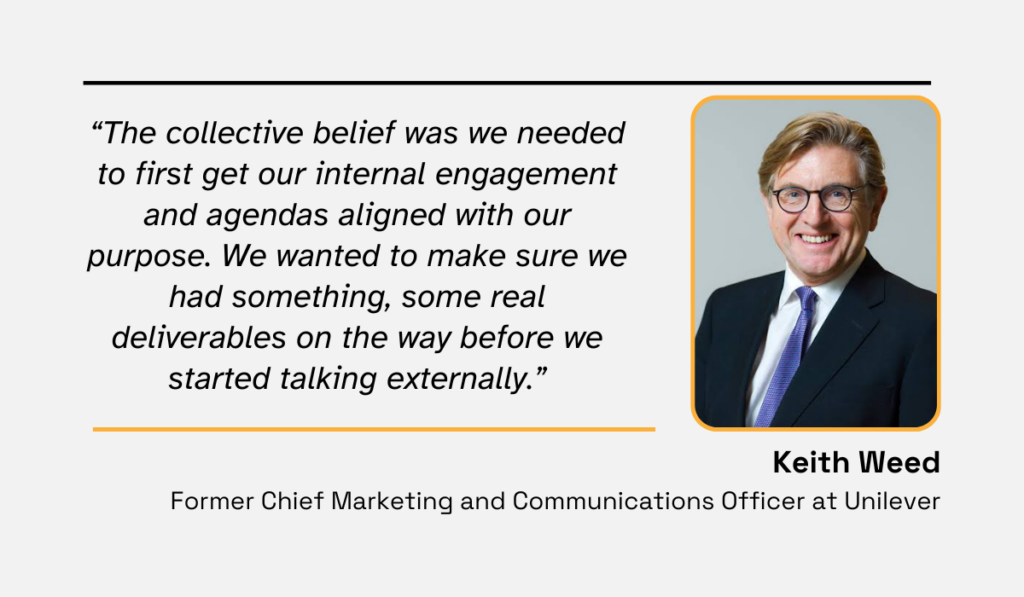
Illustration: Veridion / Quote: Fast Company
Don’t skip this crucial step, because ensuring internal alignment can significantly bolster your strategy’s success.
Finally, equip your teams with the right tools to help them carry out this strategy instead of wasting time on tedious, time-consuming tasks.
Procurement software solutions can automate numerous tasks, from spend analysis to the entire procure-to-pay process.
They also provide vital information on suppliers and market conditions, boost productivity, and minimize human error.
For example, our supplier sourcing enabler, Veridion, can help you implement and carry out your procurement strategy, whether that is strategic sourcing, green purchasing, or risk management.
Let us show you how.
First, Veridion gives you access to supplier data on millions of companies worldwide through our search APIs, which integrate seamlessly with your existing systems.
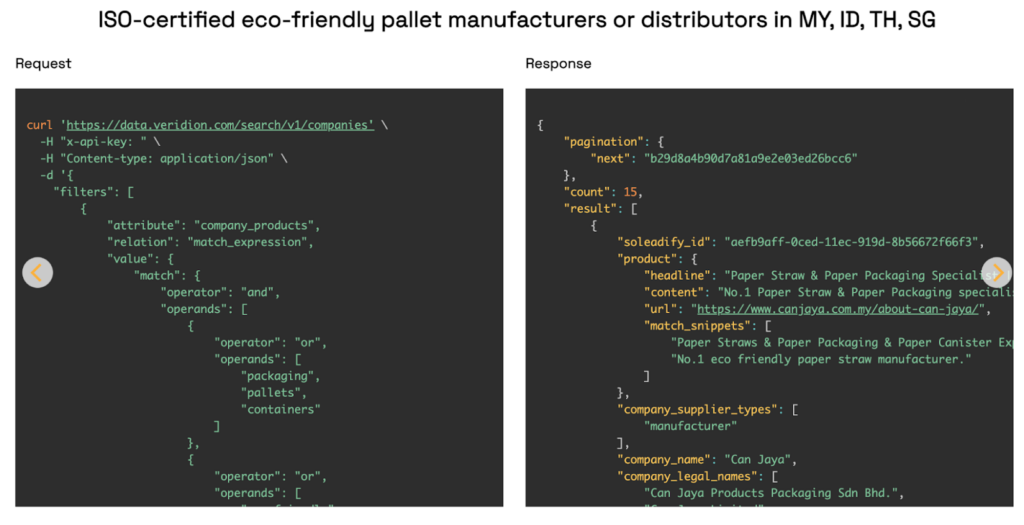
Source: Veridion
You can see firmographic information, product specifications, certifications, compliance data, and ESG characteristics, among other data points.
With this always fresh and accurate data, you can make better choices when choosing your suppliers.
Since Veridion brings ESG data on suppliers, you can easily implement sustainable procurement practices and ensure your suppliers share the same ESG values.
Finally, with Veridion’s risk management features, you can stay informed about changes in supplier activities and manage risks proactively.
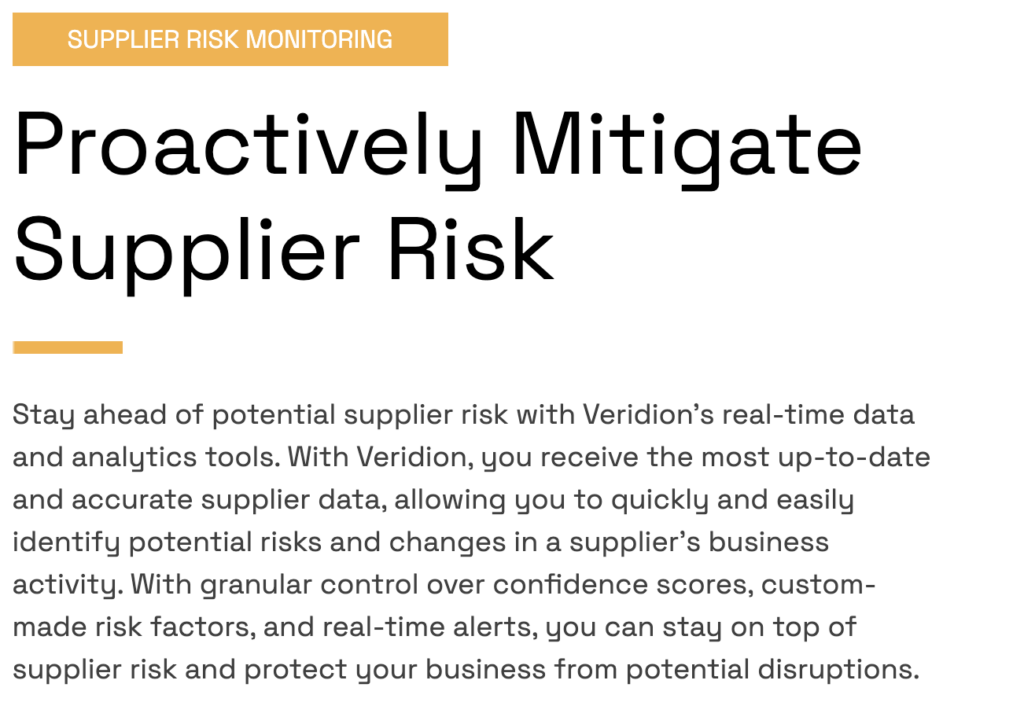
Source: Veridion
A single tool, and yet so many ways it can transform your procurement strategy!
So, explore the market for procurement software solutions that fit your specific needs and leverage them to their full potential.
Hopefully, this guide has provided valuable insights into what a procurement strategy is, why it matters, and how to create one that meets your procurement and organizational goals.
It may seem like a lot of work, and it is.
But with the right tools, proper training for your teams, and stakeholder involvement, you can develop an efficient procurement strategy.
This strategy will help you purchase products and services on time, at the right price, and with the best quality.
Beyond the core procurement functions, a well-crafted strategy will demonstrate that procurement brings much more value to your organization.
It will align procurement activities with the broader, more strategic goals of the organization, enhancing overall performance and success.